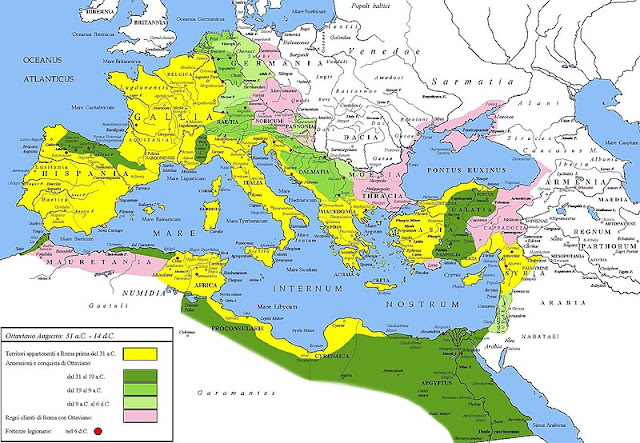The Roman Empire was the post-Republican state of ancient Rome. It included territory around the Mediterranean in Europe, North Africa, and Western Asia, and was ruled by emperors. The adoption of Christianity as the state church in 380 and the fall of the Western Roman Empire conventionally marks the end of classical antiquity and the beginning of the Middle Ages.
The Roman Republic became severely destabilized in civil wars and political conflicts, eventually culminating in the victory of Octavian over Mark Antony and Cleopatra at the Battle of Actium in 31 BC and the subsequent conquest of the Ptolemaic Kingdom in Egypt. The Roman Senate granted Octavian overarching power (imperium) and the new title of Augustus, marking his accession as the first Roman emperor of a monarchy with Italia as the metropole and Rome as its sole capital. The vast Roman territories were organized in senatorial and imperial provinces.
The first two centuries of the Empire saw a period of unprecedented stability and prosperity known as the Pax Romana (lit. 'Roman Peace'). Rome reached its greatest territorial expanse under Trajan (AD 98–117); a period of increasing trouble and decline began under Commodus (180–192).
 |
| It was reunified under Aurelian |
To stabilize it, Diocletian set up two different imperial courts in the Greek East and Latin West in 286; Christians rose to power in the 4th century following the Edict of Milan.
The imperial seat moved from Rome to Byzantium in 330. The Migration Period, involving large invasions by Germanic peoples and by the Huns of Attila, led to the decline of the Western Roman Empire. With the fall of Ravenna to the Germanic Herulians and the deposition of Romulus Augustus in 476 by Odoacer, the Western Roman Empire finally collapsed. The Eastern Roman Empire survived for another millennium with Constantinople as sole capital, until the city's fall in 1453.
Due to the Empire's extent and endurance, its institutions and culture had a lasting influence on the development of language, religion, art, architecture, literature, philosophy, law, and forms of government in its territories. Latin evolved into the Romance languages, while Medieval Greek became the language of the East. The Empire's adoption of Christianity led to the formation of medieval Christendom. Roman and Greek art had a profound impact on the Italian Renaissance. Rome's architectural tradition served as the basis for Romanesque, Renaissance and Neoclassical architecture, and also influenced Islamic architecture. The rediscovery of classical science and technology (which also formed the basis for Islamic science) in medieval Europe led to the Scientific Renaissance and Scientific Revolution. Roman law has its descendants in many modern legal systems, such as the Napoleonic Code, while Rome's republican institutions have left an enduring legacy, influencing the Italian city-state republics of the medieval period, as well as the early United States and other modern democratic republics.








No comments:
Post a Comment